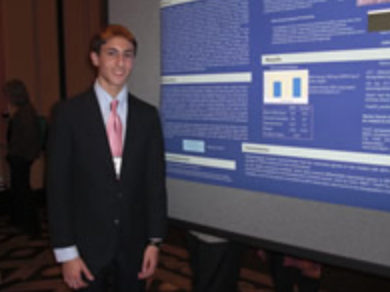2008
THE EFFECT OF PREPUBERTAL EXPOSURE TO BISPENOL A ON RAT MAMMARY GLAND MORPHOLOGY
AND GENE EXPRESSION.
Shirou Wu (1); Julia S. Pereira (1); Ricardo Lopez (1); Fathima Sheriff (1); Kara Snider (1) and Jose Russo (1). 1 Breast Cancer Research Laboratory, Fox Chase Cancer Center, Philadelphia, PA, 19111, USA.
Zachary Rotter: abstract
Bisphenol A (BPA), formerly called 4,4’- dihydroxy- 2,2-diphenylpropane, is a commonly used chemical found in re-microwaveable baby bottles and the polycarbonate lining of plastic bottles. BPA is found in normal levels in the environment, mostly as a byproduct of industrial processes. Studies have shown that the levels of BPA found in the environment are non-hazardous to human health. However, research also suggests that BPA could lead to breast cancer since BPA is an endocrine disruptor, meaning it can mimic the hormones that have a functional role in the body.
Due to these properties it was of interest to determine if BPA could alter the terminal end buds (TEBs) structures of the mammary gland, which are the target of carcinogenesis.. For this purpose we have analyzed the effects of prepubertal exposure to BPA on the 50 days old rat’s mammary gland. Nursing rats received, through gavage, 250 µg/kg body weight of BPA, during 21 days from the delivery to weaning. The female offspring were sacrificed when they reached 50 days of age. Their abdominal mammary glands were extracted and used for whole mount preparation for TEB counting, or gene expression analysis through cDNA-microarrays. The results indicated a slight decrease in the number of TEBs in mammary glands of the treated rats when compared to the control group. However, the gene expression analysis revealed changes in expression of numerous genes reported in breast cancers, such as Vav2, Nfkb1, Tnsrf11a, and Mycn. We have concluded that although prepubertal exposure to BPA does not affect significantly the rat mammary gland morphology of 50 day old rats when compared to the control group, the compound has an effect on the rat’s gene expression. BPA altered the expression of some genes that have been reported in primary breast cancer as well as in the inflammatory type.. (Zachary Rotter was supported by Huntington Breast Cancer Action Coalition fellowship, Huntington, NY, and this work was supported by NCI and NIEHS Grant UO1 ES012The Effect of Pre-pubertal 2,3,7,8-tetrachlorodibenzo-p-dioxin Exposure on Terminal End Bud Differentiation and Genetic Expression in Rat Mammary Glands. View the poster
Emily Lopes: abstract
Benzyl Butyl Phthalate (BBP) is an identified carcinogen that has been linked to breast cancer through studies conducted on Sprague Dawley rats. BBP is a commonly used plasticizer found in toys, PVC, cosmetics, and carpeting. This phthalate is absorbed into the body through inhalation, dermal and oral exposure and accumulates in the fatty tissues of the body. BBP can also be passed from mother to offspring through the placenta and during lactation. BBP is capable of binding to estrogen hormone receptors. The purpose of this study was to examine the effects of BBP on the mammary glands of Sprague Dawley rats. The animals were exposed to BBP through mother’s lactation at a concentration of 500µg/kg of body weight or equivalent volume of sesame oil (control group). At 50 days of age the animals were sacrificed and the mammary gland submitted to morphological study through whole mount preparation. The number of terminal end buds (TEBs) was counted in the abdominal mammary glands for both groups (exposed to BBP and control). The effects of the BBP were further analyzed by using cDNA-microarrays to compare the gene expression profile between the experimental and the control rats. There were not morphological differences between the control and experimental group. However, there were 80 genes significantly different in the mammary gland of BBP exposed animals compared with the matching control. The genes differentially expressed are involved in controlling the circadian rhythm such as Dopa decarboxylase (Ddc), organ development, androgen and estrogen receptors and apoptosis. These genes potentially play a role in the development of cancer cells. In conclusion, pre-pubertal exposure to BBP did not alter the mammary gland structure, but it modifies their genomic profile (*Emily Lopes was supported by the Huntington Breast Cancer Action Coalition through the Students and Scientist Environmental Research Scholarship Program. This work was supported by NCI and NIEHS Grant UO1 ES012771)
The effect of pre-pubertal exposure of Benzyl Butyl Phthalate (BBP) on the rat mammary gland.
LOCAL HIGH SCHOOL STUDENTS ATTEND THE 5TH ANNUAL EARLY ENVIRONMENTAL EXPOSURES CONFERENCE IN BIRMINGHAM, ALABAMA, NOVEMBER 2008
My Experience Presenting and Attending The Breast Cancer and Environment Research Centers (BCERC) Conference
Zachary Rotter
This year's BCERC conference was both an interesting and exhilarating experience. To be able to see ongoing research which has yet to be published, and to begin to ascertain samples of the Center Study Research Model was a wonderful challenge, as well as thought provoking opportunity. I was able to observe scientists in their 'natural habitat', so to speak. It was great seeing both Drs. Jose and Irma Russo, Fox Chase Cancer Center and other staff that I worked with in the lab last summer, and to spend professional and personal time with them. In addition, the opportunity to be able to present my own research was a major accomplishment, as I was presenting alongside many respected MD's and PhD's. I was able to reconnect with Emily and Shirou, my fellow students and intern participants at the Fox Chase Center, and also meet Carolina and Regina, two students affiliated with the Great Neck Breast Cancer Action Coalition.
Emily Lopes
Being involved in the BCERC was an amazing experience. The disciplines of the principle investigators varied and added to the strength of the breast cancer project. At this year’s conference held in Birmingham, Alabama, researchers presented and shared in their own field of science (epidemiology, genetics or lifestyle) their individual accomplishment in Breast Cancer causation. The conference was a collaboration of their work. It allowed scientists to be critical of each other’s work and provide further evidence from different perspectives. This Center Study Research Model, BCERC encourages teamwork. Representing high schools, Commack and Walt Whitman, Zachary Rotter, Shirou Wu, and I were grateful for the opportunity to work with Drs. Jose and Irma Russo and their staff at Fox Chase Cancer Center, gaining hands-on lab experience. In the spirit of BCERC, we then compiled our results and conclusions from our individual projects. It is no doubt that this research collaboration is a step forward in the prevention of Breast Cancer.




